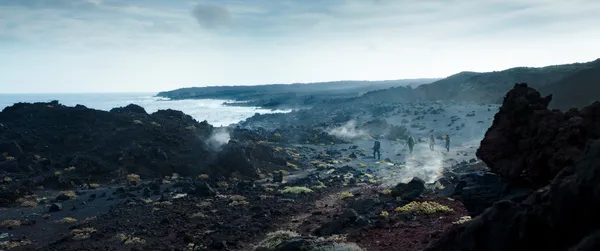 |
| "Searchers after horror haunt strange, far places" - HP Lovecraft |
Although they're all classed as horror, Cold Skin is a bit of a departure from director Xavier Gens' other films. The Divide, Hitman and Frontier(s) all confront the viewer with cold-blooded violence and focus very much of the terrors of the modern age, whereas Cold Skin takes us somewhere else entirely. Set on a remote island almost a century ago, it chronicles the strange relationship between an earnest young weather observer, a brutal lighthouse keeper and the strange, amphibious creature whom the latter keeps at his side. Every night, hordes of this creature's kin assail the lighthouse, and every night the desperate men drive them back. It's a deceptively slight story that echoes a centuries long history of conquest and the enslavement of other races, territory held by violence and men struggling to hold onto their humanity. Xavier fell in love with it as soon as he read Albert Sánchez Piñol's book.
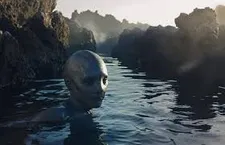 |
| At home in the water |
“I was so fascinated by that story because it talked about so many things I like,” he told me when we discussed it shortly after its screening at the Glasgow Film Festival earlier this year. "Human failings, humanity, acceptance of the other.” He immediately wanted to bring it to the screen, and found it taking shape in his head. “When I read the book I had the idea of that shot looking to the boat with the dolphin crossing under the boat. I was dreaming about that shot from the very beginning”
Finding the right location was critical to telling the story effectively. The initial plan was to shoot in Iceland.
“For me it was important because you feel what the character is feeling, and in Iceland you have that volcanic area which is full of a sense of primitive life. You have the feeling to be in a primitive land at the origin of humanity. But it was good to find somewhere else because the character of Aneris, played by Aura Garrido, is naked every day of the shoot, so it was impossible for her to play the character when it was that cold. So we found Lanzarote and that landscape was exactly like Iceland but with the warm weather. It was perfect.”
Garrido plays the amphibious prisoner, alongside Ray Stevenson as the lighthouse keeper, Gruner, and David Oakes as the weather observer, a newcomer whose name we never learn but who is referred to in the script as Friend. He's a newcomer to the island, and his experiences have been identified by many as echoing the work of HP Lovecraft.
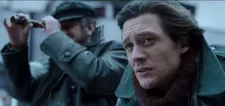 |
| Sighting land |
“Sure," says Xavier. "It’s not the same but as you have this character and he’s going into a dark gap, you think about At The Mountains Of Madness, you think about all that great book of Lovecraft’s… so we have the shadow of Lovecraft over our film because of what the film is about.”
He enjoyed being able to work with material that was different from his previous films.
“I could go into something more emotional instead of going into something too gory," he notes. "I was interested in developing my characters, their relationship and the meaning behind the film.” He tells me that he wanted to make it relevant to things that are happening in the world today as well as bringing out the historical context of the action, and that he sees the relationships in the film as central to its themes. "I wanted to make it about acceptance of the other, accepting the difference. And you can fall in love with that difference, which is what is happening to Friend and Aneris. And for me that’s something really modern that I really wanted to express in the film.”
We spoke on International Women's Day, and when I mentioned that David Oakes had told me he thought of the film as a feminist narrative, he strongly agreed.
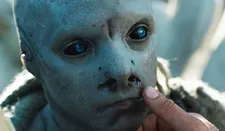 |
| Making contact |
“Yes, completely. Because at the beginning we are looking at the crouching character of Aneris and then while we have evolution in the film she’s standing on her two legs and at the end of the film she’s a woman standing in front of Friend, and she rejects the treatment of Gruner… It’s a movie about a woman who gets back her liberty and gets back her freedom."
Does Friend really understand that?
“He’s a man who has very romantic notions… He’s really fascinated by Aneris and what she represents. She’s not a beast; she’s something extraordinary.” Gruner doesn’t see this, he says, but Friend falls in love with it.
Xavier agrees that colonialism is also a significant theme in the film. “The book was made as metaphor for the Spanish invading South America,” he says, and adds that for him, a major theme was that of people trying to destroy the things they don't understand. It was important for him to make viewers believe in the creatures on the island and feel sympathy for them but also recognise their difference. In a film which relied heavily on practical effects, this began with getting their movement right. He's full of praise for Garrido's contribution.
“She had many months of training to get the movement of Aneris… when she moves, she has the legs moving first, going in front of her, and then the arms. We had to find somebody really fit to play the character because she is swimming and running all the day long. She was very fit to play the character, and then she is wearing all that prosthetic on her body, so she has eight hour make-up every day.”
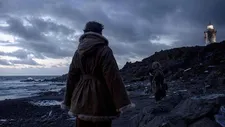 |
| Looking to the lighthouse |
He also manages to bring an old fashioned atmosphere to the film that suits its period setting.
“I love old fashioned adventure films from the Fifties," he says. "I wanted to match exactly that old feeling. We are shooting with a digital camera… you accept it’s a modern film and it’s set in the 1940s, you know? I think there is a flavour coming from those movies which I didn’t find today and I wanted to get back to. Films like Mysterious Island and 20,000 Leagues Under The Sea. It’s something I really like and I wanted to put in the film.”
The shot that sums this up for him, he says, is one of the very first ones.
“You know the wide shot when they arrive on the island? You have the small barge and the crew coming out of the boat and there is one wide shot like a picture postcard. It reminds me of Mysterious Island and a lot of movies from that period. It’s like a really slow painting. You know, when you’re reading a book and you’re not turning the pages fast, you go slowly, you take your time, and I wanted to take my time.”
So what's next for the director?
“Actually I'm finishing a French film [called Budapest] and it should be released in France on the 4th of July. It’s a true story about two friends creating a company to organise stag parties in Budapest where everything is possible. We crossed some borders on this.”
Cold Skin was released on Digital HD on April 23 and is now out on DVD.





















